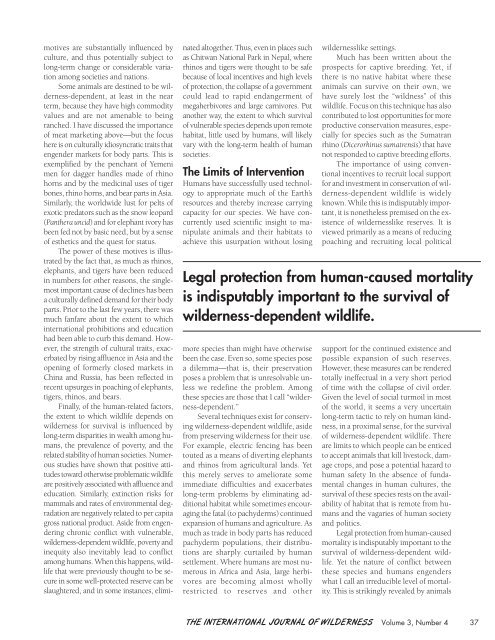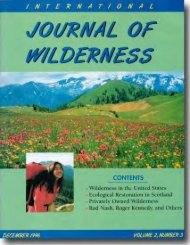Download full PDF - International Journal of Wilderness
Download full PDF - International Journal of Wilderness
Download full PDF - International Journal of Wilderness
Create successful ePaper yourself
Turn your PDF publications into a flip-book with our unique Google optimized e-Paper software.
motives are substantially influenced by<br />
culture, and thus potentially subject to<br />
long-term change or considerable variation<br />
among societies and nations.<br />
Some animals are destined to be wilderness-dependent,<br />
at least in the near<br />
term, because they have high commodity<br />
values and are not amenable to being<br />
ranched. I have discussed the importance<br />
<strong>of</strong> meat marketing above—but the focus<br />
here is on culturally idiosyncratic traits that<br />
engender markets for body parts. This is<br />
exemplified by the penchant <strong>of</strong> Yemeni<br />
men for dagger handles made <strong>of</strong> rhino<br />
horns and by the medicinal uses <strong>of</strong> tiger<br />
bones, rhino horns, and bear parts in Asia.<br />
Similarly, the worldwide lust for pelts <strong>of</strong><br />
exotic predators such as the snow leopard<br />
(Panthera uncid) and for elephant ivory has<br />
been fed not by basic need, but by a sense<br />
<strong>of</strong> esthetics and the quest for status.<br />
The power <strong>of</strong> these motives is illustrated<br />
by the fact that, as much as rhinos,<br />
elephants, and tigers have been reduced<br />
in numbers for other reasons, the singlemost<br />
important cause <strong>of</strong> declines has been<br />
a culturally defined demand for their body<br />
parts. Prior to the last few years, there was<br />
much fanfare about the extent to which<br />
international prohibitions and education<br />
had been able to curb this demand. However,<br />
the strength <strong>of</strong> cultural traits, exacerbated<br />
by rising affluence in Asia and the<br />
opening <strong>of</strong> formerly closed markets in<br />
China and Russia, has been reflected in<br />
recent upsurges in poaching <strong>of</strong> elephants,<br />
tigers, rhinos, and bears.<br />
Finally, <strong>of</strong> the human-related factors,<br />
the extent to which wildlife depends on<br />
wilderness for survival is influenced by<br />
long-term disparities in wealth among humans,<br />
the prevalence <strong>of</strong> poverty, and the<br />
related stability <strong>of</strong> human societies. Numerous<br />
studies have shown that positive attitudes<br />
toward otherwise problematic wildlife<br />
are positively associated with affluence and<br />
education. Similarly, extinction risks for<br />
mammals and rates <strong>of</strong> environmental degradation<br />
are negatively related to per capita<br />
gross national product. Aside from engendering<br />
chronic conflict with vulnerable,<br />
wilderness-dependent wildlife, poverty and<br />
inequity also inevitably lead to conflict<br />
among humans. When this happens, wildlife<br />
that were previously thought to be secure<br />
in some well-protected reserve can be<br />
slaughtered, and in some instances, elimi-<br />
nated altogether. Thus, even in places such<br />
as Chitwan National Park in Nepal, where<br />
rhinos and tigers were thought to be safe<br />
because <strong>of</strong> local incentives and high levels<br />
<strong>of</strong> protection, the collapse <strong>of</strong> a government<br />
could lead to rapid endangerment <strong>of</strong><br />
megaherbivores and large carnivores. Put<br />
another way, the extent to which survival<br />
<strong>of</strong> vulnerable species depends upon remote<br />
habitat, little used by humans, will likely<br />
vary with the long-term health <strong>of</strong> human<br />
societies.<br />
The Limits <strong>of</strong> Intervention<br />
Humans have success<strong>full</strong>y used technology<br />
to appropriate much <strong>of</strong> the Earth’s<br />
resources and thereby increase carrying<br />
capacity for our species. We have concurrently<br />
used scientific insight to manipulate<br />
animals and their habitats to<br />
achieve this usurpation without losing<br />
wildernesslike settings.<br />
Much has been written about the<br />
prospects for captive breeding. Yet, if<br />
there is no native habitat where these<br />
animals can survive on their own, we<br />
have surely lost the “wildness” <strong>of</strong> this<br />
wildlife. Focus on this technique has also<br />
contributed to lost opportunities for more<br />
productive conservation measures, especially<br />
for species such as the Sumatran<br />
rhino (Dicerorhinus sumatrensis) that have<br />
not responded to captive breeding efforts.<br />
The importance <strong>of</strong> using conventional<br />
incentives to recruit local support<br />
for and investment in conservation <strong>of</strong> wilderness-dependent<br />
wildlife is widely<br />
known. While this is indisputably important,<br />
it is nonetheless premised on the existence<br />
<strong>of</strong> wildernesslike reserves. It is<br />
viewed primarily as a means <strong>of</strong> reducing<br />
poaching and recruiting local political<br />
Legal protection from human-caused mortality<br />
is indisputably important to the survival <strong>of</strong><br />
wilderness-dependent wildlife.<br />
more species than might have otherwise<br />
been the case. Even so, some species pose<br />
a dilemma—that is, their preservation<br />
poses a problem that is unresolvable unless<br />
we redefine the problem. Among<br />
these species are those that I call “wilderness-dependent.”<br />
Several techniques exist for conserving<br />
wilderness-dependent wildlife, aside<br />
from preserving wilderness for their use.<br />
For example, electric fencing has been<br />
touted as a means <strong>of</strong> diverting elephants<br />
and rhinos from agricultural lands. Yet<br />
this merely serves to ameliorate some<br />
immediate difficulties and exacerbates<br />
long-term problems by eliminating additional<br />
habitat while sometimes encouraging<br />
the fatal (to pachyderms) continued<br />
expansion <strong>of</strong> humans and agriculture. As<br />
much as trade in body parts has reduced<br />
pachyderm populations, their distributions<br />
are sharply curtailed by human<br />
settlement. Where humans are most numerous<br />
in Africa and Asia, large herbivores<br />
are becoming almost wholly<br />
restricted to reserves and other<br />
support for the continued existence and<br />
possible expansion <strong>of</strong> such reserves.<br />
However, these measures can be rendered<br />
totally ineffectual in a very short period<br />
<strong>of</strong> time with the collapse <strong>of</strong> civil order.<br />
Given the level <strong>of</strong> social turmoil in most<br />
<strong>of</strong> the world, it seems a very uncertain<br />
long-term tactic to rely on human kindness,<br />
in a proximal sense, for the survival<br />
<strong>of</strong> wilderness-dependent wildlife. There<br />
are limits to which people can be enticed<br />
to accept animals that kill livestock, damage<br />
crops, and pose a potential hazard to<br />
human safety In the absence <strong>of</strong> fundamental<br />
changes in human cultures, the<br />
survival <strong>of</strong> these species rests on the availability<br />
<strong>of</strong> habitat that is remote from humans<br />
and the vagaries <strong>of</strong> human society<br />
and politics.<br />
Legal protection from human-caused<br />
mortality is indisputably important to the<br />
survival <strong>of</strong> wilderness-dependent wildlife.<br />
Yet the nature <strong>of</strong> conflict between<br />
these species and humans engenders<br />
what I call an irreducible level <strong>of</strong> mortality.<br />
This is strikingly revealed by animals<br />
THE INTERNATIONAL JOURNAL OF WILDERNESS Volume 3, Number 4 37










